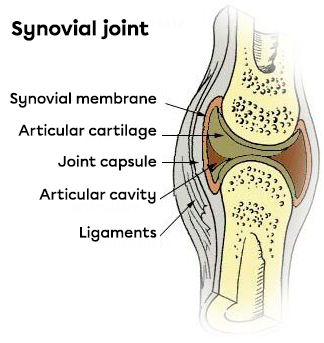The material covered in this concept sheet goes beyond what is covered in high school. This is meant to be an enrichment for students who want to find out more.
Joints
The majority of joint-related diseases are inflammatory in nature. The suffix -tis points to inflammation, so arthritis is inflammation of the joint. Other known conditions are bursitis (inflammation of the bursa, often associated with swelling) and capsulitis. Osteoarthritis is a form of arthritis caused by a deterioration of the cartilage and/or the ends of bones in the joint (after the cartilage has worn away completely). Finally, when subjected to too much tension, the ligaments can stretch or tear. This is called a sprain or strain. There are three grades of ligament injuries:
Grade 1: ligaments are stretched
Grade 2: ligaments are stretched and partially torn
Grade 3: ligaments are completely torn
Joints can be categorized according to their mobility (fixed, semi-movable or movable), but also according to their structure (fibrous, cartilaginous or synovial).
This type of joint is usually associated with fixed joints. The dense connective tissue holds the bones together along fixed joints. However, there is no cavity or cartilage. Some of these joints are semi-movable, with motility dependent on the length of the connective tissue.
The cranium (or skull) has several fixed fibrous joints.
As the name suggests, this type of joint has cartilage, but no cavity. However, these joints cannot be categorized based on their mobility, since it varies from fixed to semi-movable. A synchondrosis is a type of cartilaginous joint, usually temporary, where the cartilage is hyaline, or translucent. They are considered temporary because they are present during bone growth and seal up once the growth is complete. Instead, a symphysis is a type of joint with fibrous cartilage that acts as a shock absorber, since cartilage is both compressible and elastic.
Examples of cartilaginous joints are those between the sternum and the ribs and in the spinal column.

The cavity of this type of joint is filled with synovial fluid, also called synovia. Most joints in the body belong to this category of highly movable joints. In fact, limb joints fall into this category, since the cavity and synovial fluid enables considerable freedom of motion. This joint category presents 5 structural characteristics:
-
Each bone in this joint has a small articular cartilage pad that helps prevent compression of the epiphysis.
-
All synovial joints have an articular cavity containing synovial fluid.
-
The joint capsule, also called the synovial capsule or the articular capsule, envelops the joint cavity. There is a first layer of external tissue, composed of dense and irregular connective tissue, which attaches to the adjacent bones and is called a fibrous capsule. It provides the joint with resistance to tension. Next, the synovial membrane is made of loose connective tissue and lines the inner wall of the fibrous capsule. Along with the hyaline cartilage, its function is to enclose the synovial fluid and it therefore defines the outline of the cavity. It also has two cell types, one serving a defensive function at the immune level and the other at the protein synthesis level.
-
Synovial fluid, or synovia, primarily acts as a lubricant in the same way as grease between the gears of a machine. It has a viscous consistency similar to egg whites, but decreases in viscosity when it warms. It is present in the joint cavity as well as inside the cartilage. The cartilage acts as a sponge: liquid flows out of the joint when the cartilage is compressed and back in when it is no longer compressed. This lubrication mechanism reduces friction.
-
Finally, ligaments strengthen joints by binding bones together. There are two types of ligaments: the capsular ligaments are made up of a thickening of the fibrous capsule and the external and internal ligaments are located outside or inside the capsule, but are independent of it.
-
The capsule and ligaments are rich in sensory nerve endings that provide the cerebrum with information about joint positions at any time. Other structures outside the joint also participate in its lubrication. These structures are the bursa and the tendon sheath.
Examples of synovial joints are the knees, hips, wrists and elbows.